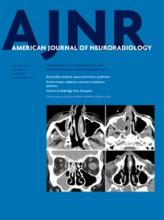Index by author
Na, D.G.
- Head and Neck ImagingYou have accessThe Role of Core Needle Biopsy and Its Impact on Surgical Management in Patients with Medullary Thyroid Cancer: Clinical Experience at 3 Medical InstitutionsE.J. Ha, J.H. Baek, D.G. Na, J.-h. Kim, J.K. Kim, H.S. Min, D.E. Song, K.E. Lee and Y.K. ShongAmerican Journal of Neuroradiology August 2015, 36 (8) 1512-1517; DOI: https://doi.org/10.3174/ajnr.A4317
Nahab, F.
- Adult BrainYou have accessPerformance and Predictive Value of a User-Independent Platform for CT Perfusion Analysis: Threshold-Derived Automated Systems Outperform Examiner-Driven Approaches in Outcome Prediction of Acute Ischemic StrokeS. Dehkharghani, R. Bammer, M. Straka, L.S. Albin, O. Kass-Hout, J.W. Allen, S. Rangaraju, D. Qiu, M.J. Winningham and F. NahabAmerican Journal of Neuroradiology August 2015, 36 (8) 1419-1425; DOI: https://doi.org/10.3174/ajnr.A4363
Nolte, C.H.
- EDITOR'S CHOICEAdult BrainOpen AccessHyperintense Vessels on FLAIR: Hemodynamic Correlates and Response to ThrombolysisA. Kufner, I. Galinovic, V. Ambrosi, C.H. Nolte, M. Endres, J.B. Fiebach and M. EbingerAmerican Journal of Neuroradiology August 2015, 36 (8) 1426-1430; DOI: https://doi.org/10.3174/ajnr.A4320
The authors evaluated 62 consecutive patients with ischemic stroke with proven vessel occlusion with MRI before and within 24 hours of treatment and defined a hypoperfusion intensity ratio (volume with severe/mild hypoperfusion [time-to-maximum ≥ 8 seconds / time-to-maximum ≥ 2 seconds]). Patients with extensive hyperintense vessels on FLAIR (>4 sections) had higher NIHSS scores, larger baseline lesion volumes, higher rates of perfusion-diffusion mismatch, and more severe hypoperfusion intensity ratio.
Okazaki, T.
- NeurointerventionYou have accessVascular Wall Imaging of Unruptured Cerebral Aneurysms with a Hybrid of Opposite-Contrast MR AngiographyT. Matsushige, Y. Akiyama, T. Okazaki, K. Shinagawa, N. Ichinose, K. Awai and K. KurisuAmerican Journal of Neuroradiology August 2015, 36 (8) 1507-1511; DOI: https://doi.org/10.3174/ajnr.A4318
Oleaga, L.
- Adult BrainYou have accessPerfusion Deficits and Mismatch in Patients with Acute Lacunar Infarcts Studied with Whole-Brain CT PerfusionS. Rudilosso, X. Urra, L. San Román, C. Laredo, A. López-Rueda, S. Amaro, L. Oleaga and Á. ChamorroAmerican Journal of Neuroradiology August 2015, 36 (8) 1407-1412; DOI: https://doi.org/10.3174/ajnr.A4303
Ostergaard, L.
- Adult BrainOpen AccessMean Diffusional Kurtosis in Patients with Glioma: Initial Results with a Fast Imaging Method in a Clinical SettingA. Tietze, M.B. Hansen, L. Østergaard, S.N. Jespersen, R. Sangill, T.E. Lund, M. Geneser, M. Hjelm and B. HansenAmerican Journal of Neuroradiology August 2015, 36 (8) 1472-1478; DOI: https://doi.org/10.3174/ajnr.A4311
Ozbek, U.
- Adult BrainOpen AccessEvaluating CT Perfusion Deficits in Global Cerebral Edema after Aneurysmal Subarachnoid HemorrhageH. Baradaran, V. Fodera, D. Mir, K. Kesavobhotla, J. Ivanidze, U. Ozbek, A. Gupta, J. Claassen and P.C. SanelliAmerican Journal of Neuroradiology August 2015, 36 (8) 1431-1435; DOI: https://doi.org/10.3174/ajnr.A4328
Pascual, J.M.
- LetterYou have accessTopographic Diagnosis of Papillary Craniopharyngiomas: The Need for an Accurate MRI-Surgical CorrelationJ.M. Pascual, R. Prieto, I. Castro-Dufourny and R. CarrascoAmerican Journal of Neuroradiology August 2015, 36 (8) E55-E56; DOI: https://doi.org/10.3174/ajnr.A4441
Peck, K.K.
- FELLOWS' JOURNAL CLUBFunctionalYou have accessChallenges in Identifying the Foot Motor Region in Patients with Brain Tumor on Routine MRI: Advantages of fMRIR.A. Fisicaro, R.X. Jiao, C. Stathopoulos, N.M. Petrovich Brennan, K.K. Peck and A.I. HolodnyAmerican Journal of Neuroradiology August 2015, 36 (8) 1488-1493; DOI: https://doi.org/10.3174/ajnr.A4292
Thirty-five attending-level raters evaluated 14 brain tumors involving the frontoparietal convexity. Raters identified the location of the foot motor homunculus and determined whether the tumor involved the foot motor area and/or motor cortex by using anatomic MR imaging. Seventy-seven percent of the time raters correctly identified whether the tumor was in the foot motor cortex. Raters with fMRI experience were significantly better than raters without experience at foot motor fMRI centroid predictions.
Petrovich Brennan, N.M.
- FELLOWS' JOURNAL CLUBFunctionalYou have accessChallenges in Identifying the Foot Motor Region in Patients with Brain Tumor on Routine MRI: Advantages of fMRIR.A. Fisicaro, R.X. Jiao, C. Stathopoulos, N.M. Petrovich Brennan, K.K. Peck and A.I. HolodnyAmerican Journal of Neuroradiology August 2015, 36 (8) 1488-1493; DOI: https://doi.org/10.3174/ajnr.A4292
Thirty-five attending-level raters evaluated 14 brain tumors involving the frontoparietal convexity. Raters identified the location of the foot motor homunculus and determined whether the tumor involved the foot motor area and/or motor cortex by using anatomic MR imaging. Seventy-seven percent of the time raters correctly identified whether the tumor was in the foot motor cortex. Raters with fMRI experience were significantly better than raters without experience at foot motor fMRI centroid predictions.








